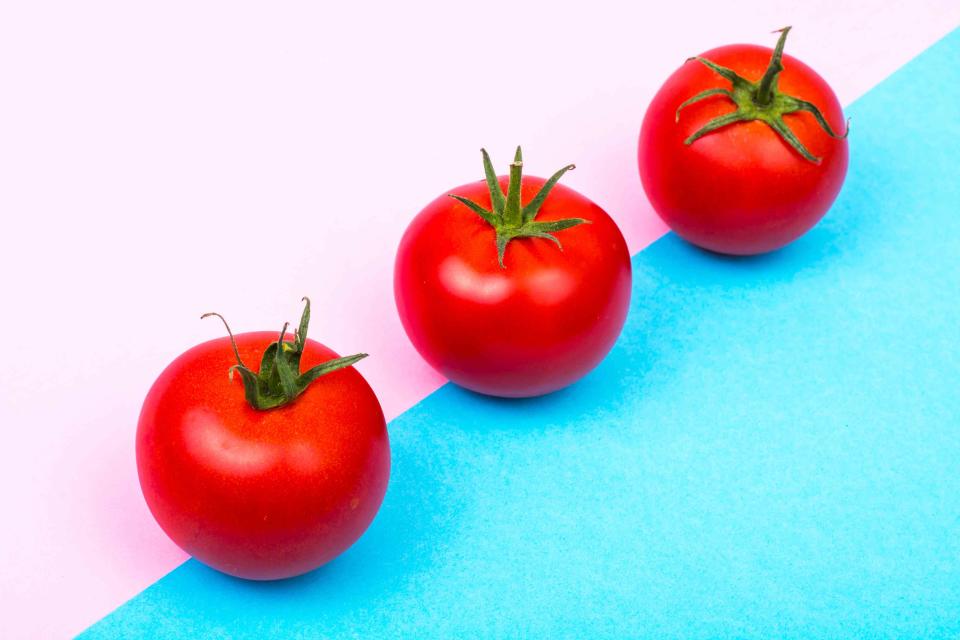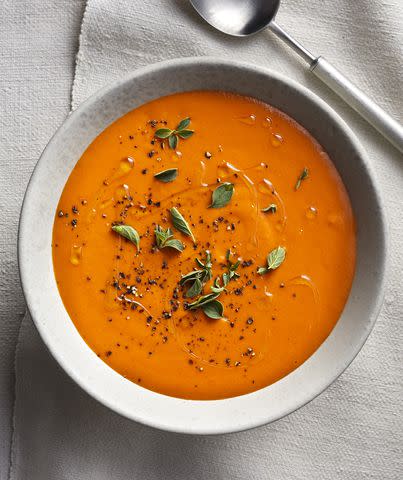The 6 Healthiest Reasons to Love Tomatoes—Both Fresh and Canned
It’s more than the prize produce of summer or the star of marinara sauce—the humble tomato is very, very good for you, too.

ArtCookStudio/Getty Images
Tomatoes are one of the most widely used types of produce (often referred to as vegetables, but technically, botanically a fruit), featuring in almost every cuisine around the world. And it’s no wonder why—ripe tomatoes are fresh and juicy (they’re 95 percent water!), sweet and slightly tart, livening up any meal. Whether eaten fresh or cooked, from the farmers’ market or out of a can, tomatoes taste delicious and can transform into just about anything—from a Bloody Mary cocktail, to a fresh salad, to a hearty pasta sauce—making them a very versatile ingredient.
Tomatoes are also super nutritious, supporting your heart, blood pressure, cholesterol management, skin, immune system, vision, and gut health—the list is long. Read on to discover more about the top tomato health benefits, as well as tips on how to incorporate tomatoes into your meals.
Related:How to Store Tomatoes So They Don't Get Mealy
Tomatoes provide a wealth of antioxidants.
Tomatoes are full of different antioxidants, including lycopene, beta-carotene, lutein, chlorogenic acid, and naringenin, says Aubrey Redd, MS, RDN, LDN, registered dietitian and owner of Aubrey Redd Nutrition.
“Antioxidants help fix the damage from oxidative stress in our body,” explains Amandeep Kalsi, MPH, RD, registered dietitian in California. A host of things can cause this oxidative dress, from pollution to UV rays, so it is impossible to avoid. This is another reason why it is a good idea to include brighter- and/or deeper-colored vegetables and fruits in your diet, as these tend to have a higher number of antioxidants, Kalsi says.
Lycopene is the antioxidant which gives the tomato its characteristic red color. According to Redd and Kalsi, studies have found that having more lycopene present in the body is associated with a lowered risk of heart disease and even certain cancers.
The next antioxidant is beta-carotene, which is converted to vitamin A within the body. Vitamin A is important for eye health and the immune system, Kalsi says. It also plays a part in preventing collagen from breaking down and boosting collagen production in our skin. “There’s a study that shows that when participants consumed a combination of tomato paste and olive oil for 10 weeks, they saw a 40 percent increase in protection against sunburns,” she adds. This is thanks to the beta-carotene in tomatoes!
Finally, tomatoes also contain lutein, which helps prevent age-related macular degeneration, chlorogenic acid, which helps lower blood pressure, and naringenin in the tomato skin, which helps reduce inflammation, Redd says.
Related:9 Polyphenol-Rich Foods (and Drinks)—Plus Healthy Ways to Eat More of Them
Tomatoes are extremely high in vitamin C.
Tomatoes can provide you with 25 percent of the recommended Daily Value (DV) of vitamin C, offering 13.7 milligrams of C per 100 grams. Vitamin C, which is yet another antioxidant, helps build your immune cells and supports tissue growth and healing, Redd says. The regeneration of other antioxidants in the body, like vitamin E, also depends on vitamin C.
For vegetarians and vegans who may not get their iron from animal foods, vitamin C is especially important, as it helps the body absorb the iron from plant-based foods more readily.
Tomatoes offer both soluble fiber and insoluble fiber.
Healthy adult women should aim for 25 grams of fiber per day (38 grams for men). A medium tomato provides 1.5 grams of fiber, made up of insoluble and soluble fiber, both of which are necessary and helpful for digestion.
Insoluble fiber attracts water into your stool to soften it and allow for smooth passage out of the body, Kalsi explains. It is especially beneficial if you have issues with constipation.
Soluble fiber is great to include in your diet if you’re monitoring your blood glucose (sugar) levels, Redd says, as it slows down the digestion and absorption of carbohydrates, so your blood sugar levels don’t spike too quickly—and so you feel satisfied for longer after eating. “Soluble fiber also works as a prebiotic in our gut,” explains Redd. “Prebiotics are the foods that are going to nourish our healthy gut bacteria.”
Tomatoes are a good source of potassium.
“[Tomatoes are] one of the produce items with the highest amount of potassium,” Redd says, with 290 mg of this essential mineral in a medium tomato. Potassium plays a role in ensuring our body retains the amount of water it needs to be well-hydrated (it’s an electrolyte), she says, and also helps with healthy blood pressure control. The presence of potassium in your blood causes the kidneys to lower the sodium levels in your bloodstream, which, in turn, lowers your blood pressure, Kalsi explains.
But do note: Eating too much potassium can negatively affect you if you have kidney disease or are on medications that impact your body’s ability to handle potassium. Speak to your doctor about how much potassium you can have per day if you aren’t sure.
Tomatoes have vitamin K for blood and bone health.
A medium tomato contains approximately 15 percent of the recommended DV of vitamin K. According to Redd and Kalsi, vitamin K has a role in forming and activating proteins that are involved in blood clotting and strengthening bone.
Tomatoes contain folate, an important B vitamin.
Folate, also known as vitamin B9, supports normal tissue growth and cell function, Redd and Kalsi say. For those who are pregnant, folate also helps prevent neural tube defects in the growing fetus during pregnancy, making it especially important for pregnant people to get enough of it.
Related:These 12 Healthy Foods Are Exceptionally High in Vitamin B
The Health Benefits of Cooked vs. Fresh Tomatoes
Will you get less nutrition from tomatoes if you only eat them cooked? Not at all, says Redd. In fact, according to Kalsi, “there is a higher concentration of lycopene in tomatoes when they are cooked.” So go ahead and use canned tomatoes, stewed tomatoes, or tomato-based pasta sauces, only remember to go for the ‘no added sodium’ varieties, if and when available.
The other thing to note: As often as possible, try to consume tomatoes together with a healthy fat source, like olive oil or avocado. “It actually increases your body’s absorption of lycopene by four times,” Kalsi says. This is your sign to enjoy a caprese salad or some tomato and avocado salsa!
Related:11 Fresh Tomato Recipes to Use Up Your Best Heirloom Varieties
Easy Tomato Recipes
Tomato Tart With Mustard Créme Fraîche

Fresh Cavatelli With Garlic Tomato Sauce

Vegan Creamy Tomato Soup

Tomato-Braised Pork

Braised Fish With Spicy Tomato Sauce

Related:What's the Difference Between Tomato Sauce and Tomato Paste? We Break It Down
For more Real Simple news, make sure to sign up for our newsletter!
Read the original article on Real Simple.

